Non-surgical rhinoplasty
| Non-Surgical Rhinoplasty | |
|---|---|
| Intervention | |
| ICD-9-CM | 21.87 |
| MeSH | D012225 |
Non-surgical rhinoplasty is a medical procedure in which injectable fillers, most commonly hyaluronic acid ones like Restylane and Juvederm or calcium hydroxyapatite (Radiesse), are used to alter and shape a person's nose without invasive surgery.[1][2] The procedure fills in depressed areas on the nose, lifting the angle of the tip or smoothing the appearance of bumps on the bridge.[3] Non surgical rhinoplasty is an augmentation procedure, so it cannot reduce the size of someone's nose. It is a cosmetic procedure and is used sometimes to correct functional problems with the nose, such as breathing difficulties.
Originally developed at the turn of the century, early attempts used soft-tissue fillers such as paraffin wax and silicone. The procedure was abandoned when disastrous late complications started appearing.[4] More modern fillers are now in use.
History
Non-surgical rhinoplasty is reported to have originated at the turn of the nineteenth century, when New York City neurologist James Leonard Corning (1855–1923) and Viennese physician Robert Gersuny (1844–1924) began using liquid paraffin wax to elevate the "collapsed nasal dorsum" that characterizes the "saddle nose deformity." Yet, despite its corrective efficacy, liquid paraffin proved biologically harmful.[3]
During the 1960s, soft-tissue fillers of medical-grade silicone gel were introduced to the rhinoplastic surgeons. However, like liquid paraffin, silicone gels proved biologically harmful, causing ulcers and granulomas, as reported in 1977.[5] To minimize the risk, in 2000 D.S. Orentreich advocated the "microdroplet technique", minute doses of silicone injected over multiple sessions.[6]
In 1977, Robert Kotler, MD, FACS, learned the microdroplet technique from Jack Startz, M.D. and began offering a permanent nose job to his patients. Appointments were separated by five to six weeks; the procedure cost 80 less than a surgical rhinoplasty.
In 2002, American otolaryngologist Dr. Alexander Rivkin began using injectable fillers like Restylane and Radiesse that had recently been approved by the FDA to improve the contours of his patients' noses. He developed an office based procedure consisting of a series of small filler injections in precise locations on the nose. After performing the procedure regularly in 2003, Rivkin publicized the method in a variety of mainstream American news outlets[7] as the "non-surgical nose job" and "injection rhinoplasty."[3][8] The main goal of the procedure was to make a bumpy or curved nose appear straighter. He observed that straightening the nose made it appear smaller (even though he was augmenting) by making it blend better with the contours of the rest of the face.[9][10] This observation was echoed by later physicians as well.[11] Rivkin's 2009 study of 385 patients remains the largest published experience with this technique in the world.[10]
In 2005, the Australian Dr. Andrew Tuan-Anh Le published a pilot study reporting successful corrective outcomes using the soft-tissue filler polyacrylamide gel (PAAG), a hydrophilic colloid injected to the tissues of the nasal defect, and known commercially as Aquamid.[12][13] Other soft-tissue fillers have since come into use as well, and the injection procedures have gained popularity due to their non-invasiveness and low cost.
Procedure overview
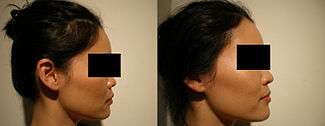
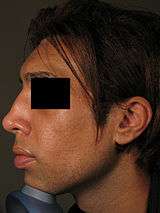
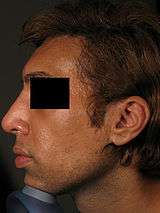
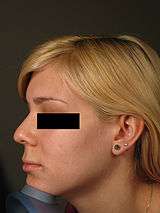
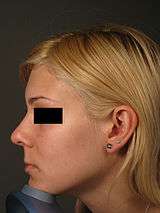
Because the nose is the anchor-feature of the face, an aesthetically proportionate nose balances the physiognomic features of a person. Non-surgical correction is considered for patients with a treatment-suitable aesthetic defect, or a defect resulting from a surgical rhinoplasty (either primary or secondary). Although the procedure is usually performed for aesthetic purposes, it can also be used to correct some birth defects. Because the procedure is not invasive, bruising and swelling are minimal. The procedure is not meant to decrease nose size, although it can make the nose appear smaller by making it look straighter. It is frequently used to increase the height and definition of the nasal bridge, as well as augmenting other precisely defined areas of the nose. The procedure is not used to correct functional defects. Non-surgical rhinoplasty is used by patients of all ethnicities.
The filler-injection technique allows for:
- the augmentation of a flat nasal bridge (depressed dorsum)
- the added projection of the nasal tip
- correction of retracted columella
- small reduction of nostril size
- the perceptual diminution of a nasal hump
- filling a nasal sidewall depression
- enhancing a retracted anterior nasal spine
- the enhancement of a retracted maxilla lateral to the pyriform (pear-shaped) aperture to displace the anterior plane
- the elevation of a saddle nose deformity caused by a failed primary rhinoplasty
- traumatic injury[14]
As with other aesthetic procedures, possible complications of the procedure can include infection, hematoma, discomfort, anatomic asymmetry, or foreign body reaction (called granulomas). Granulomas are extremely rare, and are most seen with impure silicone and some of the early non-modern versions of methyl-methacrylate (Artecoll or Arteplast, though not Artefill).[3]
Modern fillers
- Calcium hydroxyapatite (Radiesse) – A calcium based, non allergenic filler that is sturdier than hyaluronic acid and lasts for 10 to 14 months. It is not reversible, however.
Duration of results depends on the type of filler used. Modern injectable soft-tissue filler agents include:
- Hyaluronic acid (Juvederm, Restylane, Perlane or Voluma) – a safe and non allergenic temporary filler that lasts for 6 to 10 months. This filler can be dissolved with injections of an enzyme called hyaluronidase.[10]
- Liquid silicone – Medical grade silicone is sometimes used in a microdroplet technique for permanent versions of the procedure.
- Polyacrylamide gel (PAAG or Aquamid) – A permanent filler used most frequently in Asia and Australia. Some studies have since found increased complications with Aquamid. It is not approved by the U.S. FDA.[3]
- Polymethylmethacrylate (Artefill) – A permanent filler made from inert, microscopic surgical plastic beads. It is packaged with bovine collagen as a carrier, so a skin test is necessary prior to treatment. This filler is injected over several treatment sessions.[15][16]
Techniques
The preferred anesthesia for non surgical rhinoplasty is topical cream (topical anesthesia). Some physicians use local anaesthesia (i.e. lidocaine injections), but that can obscure the area being injected.
The physician injector uses a sterile syringe, prepackaged with filler and a hypodermic needle (e.g. 27-G, 25 mm) to inject the material under the nasal skin, most commonly in the deep subcutaneous tissues, immediately above the periosteum.
The procedure for injecting and placing the soft-tissue filler typically take 10 to 30 minutes to perform in the surgeon's consultation room, after an initial 15 minutes of numbing. After the procedure, the patient can typically resume normal life activities immediately.
See also
References
- ↑ Beer, K.R., Nasal reconstruction using 20 mg/ml cross-linked hyaluronic acid. J Drugs Dermatol, 2006. 5(5): p. 465-6.
- ↑ Rokhsar, C. and D.H. Ciocon, Nonsurgical rhinoplasty: an evaluation of injectable calcium hydroxylapatite filler for nasal contouring. Dermatol Surg, 2008. 34(7): p. 944-6.
- 1 2 3 4 5 Alexander Rivkin; Kontis TC (May 2009). "The history of injectable facial fillers". Facial Plastic Surgery. 25 (2): 67–72. doi:10.1055/s-0029-1220645. PMID 19415573.
- ↑ Stupak HD, Moulthrop TH, Wheatley P, Tauman AV, Johnson CM Jr. Calcium hydroxylapatite gel (Radiesse) injection for the correction of postrhinoplasty contour deficiencies and asymmetries. Arch Facial Plast Surg. 2007 Mar-Apr;9(2):130-6.
- ↑ Wilkie TF (August 1977). "Late development of granuloma after liquid silicone injections". Plast. Reconstr. Surg. 60 (2): 179–88. doi:10.1097/00006534-197708000-00004. PMID 887659.
- ↑ Orentreich DS (October 2000). "Liquid injectable silicone: techniques for soft tissue augmentation". Clin Plast Surg. 27 (4): 595–612. PMID 11039892.
- ↑ "15 Minute Nose Job by Dr. Alexander Rivkin". NBC. Retrieved 2010-07-03.
- ↑ "Introduction". Westside Aesthetics. Retrieved 2010-07-03.
- ↑ Dr. Alexander Rivkin performing non-surgical rhinoplasty on NBC's Today Show
- 1 2 3 Alexander Rivkin (December 2009). "P. Nonsurgical Injection Rhinoplasty with Calcium Hydroxylapatite in a Carrier Gel (Radiesse): A 4-Year, Retrospective Clinical Review". Cosmetic Dermatology. 22 (12): 619–624.
- ↑ Dayan SH, Greene RM, Chambers AA. Long-lasting injectable implant for correcting cosmetic nasal deformities. Ear Nose Throat J. 2007 Jan;86(1):25-6.
- ↑ Le, Andrew Tuan-anh (2005). "Rhinoplasty Using Injectable Polyacrylamide Gel — A Patient Study". Australasian Journal of Cosmetic Surgery. 1 (1).
- ↑ BHC — Non-surgical Rhinoplasty Kuwait — Beauty and Health Care Kuwait Injectable Rhinoplasty.
- ↑ "Non-Surgical Revision Rhinoplasty". Robert Kotler, MD, FACS. Retrieved 16 January 2012.
- ↑ Rhinoplasty/ "Permanent, Non-surgical Rhinoplasty" Check
|url=value (help). Robert Kotler, MD, FACS. Retrieved 28 July 2016. - ↑ Alexander Rivkin (May 2009). "New fillers under consideration: what is the future of injectable aesthetics?". Facial Plastic Surgery. 25 (2): 120–123. doi:10.1055/s-0029-1220652. PMID 19415580.
External links
- Demonstration of non-surgical rhinoplasty on NBC's Today Show (video)
- Demonstration by animation of non-surgical rhinoplasty (video)
- Non Surgical Nose Job Treatment Demonstration Video
